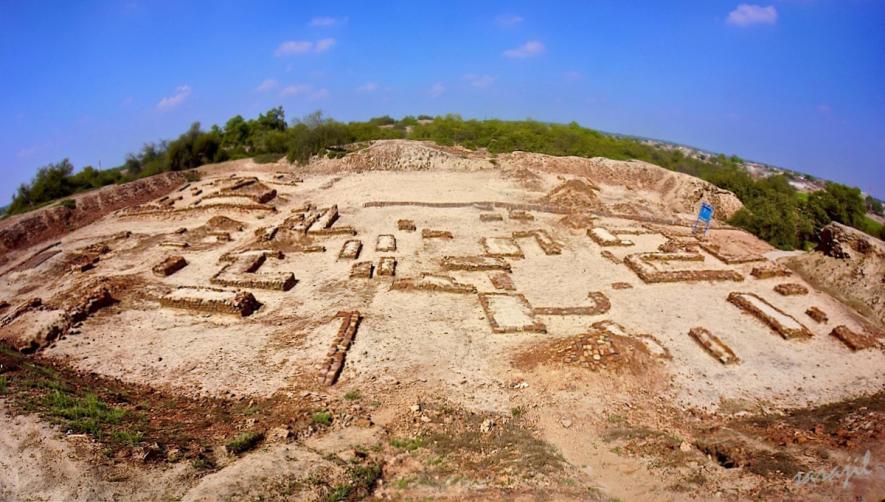Why Are Archaeologists Unable to Find Evidence of a Ruling Class of Indus Civilisation?

Archaeological Site of Harappa. Image Courtesy: Wikimedia Commons
Little more than a century ago, British and Indian archaeologists began excavating the remains of what they soon realised was a previously unknown civilisation in the Indus Valley. Straddling parts of Pakistan and India and reaching into Afghanistan, the culture these explorers unearthed had existed at the same time as those of ancient Egypt and Mesopotamia, and covered a much larger area. It was also astonishingly advanced: sophisticated and complex, boasting large, carefully laid out cities, a relatively affluent population, writing, plumbing and baths, wide trade connections, and even standardised weights and measures.
What kind of a society was the Indus Valley Civilisation, as it came to be known? Who lived there and how did they organise themselves? Archaeologists and other experts ask these questions to this day, but the first explorers were already noticing some unique features.
In Mesopotamia and Egypt, “much money and thought were lavished on the building of magnificent temples for the gods and on palaces and tombs of kings,” observed Sir John Marshall, who supervised the excavation of two of the five main cities, Harappa and Mohenjo-daro, “but the rest of the people seemingly had to content themselves with insignificant dwellings of mud.”
In the Indus Valley, “the picture is reversed and the finest structures were those erected for the convenience of the citizens. Temples, palaces, and tombs there may of course have been, but if so, they are either still undiscovered or so like other edifices as not to be readily distinguishable from them.”
In its heyday, from about BC 2600 to BC 1900, the Indus Valley Civilisation created what may have been the world’s most egalitarian early complex society, defying long-held presumptions about the relationship between urbanisation and inequality in the past. Its large cities were expansive, planned, and boasted large-scale architecture, including roomy residential houses, and smaller settlements in the surrounding areas appeared to support a similar culture with a similar standard of living.
The most tantalising feature of the ancient Indus Valley remains is what they appear to lack: any trace of a ruling class or managerial elite. This defies the long-time theoretical assumption that any complex society must have stratified social relations: that collective action, urbanisation, and economic specialisation only develop in a very unequal culture that takes direction from the top, and that all social trajectories evolve toward a common and universal outcome, the state. Yet, here was a stable, prosperous civilisation that appeared to remain that way for centuries without a state, without priest-kings or merchant oligarchs, and without a rigid caste system or warrior class. How did they manage it?
Unfortunately, in the early decades of exploration and research, archaeologists tended to assume that lack of evidence of a top-down, hierarchical society in the Indus Valley remains meant only that they had not yet been found. Some have argued that lack of evidence of inequality only indicates that the region’s ruling class was very clever at disguising the boundaries between itself and other social strata.
Pointing to the fact that Indus Valley burial sites contain no monumental tombs, some researchers suggest that the rulers may have been cremated or deposited in rivers, as was the practice in other imperial cultures. But cremation is not archaeologically invisible; the remains of other cultures often include evidence of it.
More recently, archaeologists have been willing to go back to the original explorers’ observations and use the evidence directly in front of them to develop theories about ancient life in the Indus Valley Civilisation.
Archaeological data from South Asia has improved greatly: and there is much more of it. Numerous Indus sites are now known to archaeologists that decades ago were not, and the environmental contexts that enabled urbanisation in the region—climate, natural resources—are now much clearer.
Archaeologists have also honed a strong set of tools for identifying inequality and class divisions: from mortuary data, palace assemblages, aggrandizing monuments, written records, and soon, possibly, from household data. Yet, in a century of research, archaeologists have found no evidence of a ruling class in the Indus Valley that is comparable to those recovered in other early complex societies.
In the late 1990s, Indus archaeologists started to consider a new concept that seemed to better fit the facts. Heterarchy asserts that complex political organisation, including cities, can emerge through the interaction of many different, unranked social groups, rather than from top-down decisions by an elite: that cooperation, not domination, can produce collective action. It’s now widely argued that multiple social groups contributed to the construction of Indus cities and the economic activities that took place in them, and that none seemed to dominate the others.
Bolstering this argument, no evidence exists that any group of Indus producers was excluded from the use of scarce materials that craftspeople had to obtain from long distances away, or that particular groups limited access to those materials to seize a higher position for themselves in Indus society.
One of the most distinctive and technically dazzling products of the Indus culture are stamped seals engraved with imagery and text; over 2,500 have been found at Mohenjo-daro alone. But the seals were produced by many different groups of artisans in many locations, and there is no evidence that a ruling class controlled production. Technological styles tended to cross-cut different groups of artisans, indicating a great deal of openness and knowledge sharing.
Indus city-dwellers built large- and small-scale public buildings; the Great Bath at Mohenjo-daro is a massive structure that contained a large paved bath assembled from tightly fitted baked bricks, waterproofed with bitumen and supplied with pipes and drains that would have allowed control over water flow and temperature. At Mohenjo-daro, non-residential structures were built atop brick platforms that were as substantial as the structures erected on top of them, and would have required a great deal of coordinated action. It’s been calculated that just one of the foundation platforms would have required four million days of labour, or 10,000 builders working for more than a year.
Yet, at both Harappa and Mohenjo-daro, these large non-residential structures were relatively accessible, suggesting that they were “public,” as opposed to palaces or administrative centres restricted to a privileged class. Some of these may have served as specialised spaces for exchange, negotiation, and interaction between different groups clustered in neighbourhoods or along important streets and roads. These spaces may have helped the city-dwellers maintain a high degree of consensus on planning and policy and ensured that no one group was able to accumulate wealth at the expense of the rest.
The Indus Valley remains have yet to yield all of their riches. The Indus script has yet to be deciphered, and we still don’t know why the civilisation started to decline in the second millennium BC. One of the most positive recent developments has been a dramatic increase in data and interest in the civilisation’s small-scale settlements, which may shed light on the question whether these settlements were qualitatively different from one another or from the cities—and how far Indus egalitarianism extended across its broader landscape.
What we have already found, however, suggests that egalitarianism may have been a boon to collective action: that distinct social groups may have been more willing to invest in collective action if the benefits were not restricted to a subset of elites. That suggests that heterarchy may act as a kind of brake on coercive power amongst social groups, and across society as a whole.
If this is the case, and after a century of research on the Indus civilisation, archaeologists have not found evidence for a ruling class comparable what’s been recovered in other early complex societies, then it’s time to address the Indus Valley’s egalitarianism.
Urbanisation, collective action, and technological innovation are not driven by the agendas of an exclusionary ruling class, the evidence suggests, and can occur in their total absence. The Indus Valley was egalitarian not because it lacked complexity, but rather because a ruling class is not a prerequisite for social complexity. It challenges us to rethink the fundamental connections between collective action and inequality.
The priest-king is dead: or, in this case, most likely never existed.
Adam S. Green is a lecturer in sustainability at the University of York. He is an archaeological anthropologist focused on South Asia, specialising in the comparative study of early states through the lenses of technology, the environment, and political economy.
This article was produced by Human Bridges, a project of the Independent Media Institute.
Get the latest reports & analysis with people's perspective on Protests, movements & deep analytical videos, discussions of the current affairs in your Telegram app. Subscribe to NewsClick's Telegram channel & get Real-Time updates on stories, as they get published on our website.
























